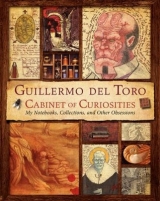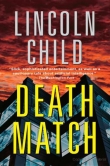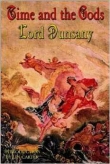
Текст книги "Cabinet of Curiosities: My Notebooks, Collections, and Other Obsessions"
Автор книги: Guillermo del Toro
Соавторы: Marc Scott Zicree
Жанры:
Публицистика
,сообщить о нарушении
Текущая страница: 5 (всего у книги 17 страниц)
ANALYZING FILM
MSZ: One very distinctive quality about your film work is that it’s enormously tactile, textural, lyrical. There’s a sense that every moment, every image, is handmade, as if you’re sculpting every shot. Viewers can revisit your films over and over again.
GDT: Well, if they want to. I do put a lot in the audiovisual coding of a movie. Some is rational, but then another 50 percent is instinctive—the way you arrange things. I think a director is an arranger. Alien is the perfect example. It’s an absolutely mind-boggling feat of filmmaking. People can say, “Oh, well, it’s Giger.” No, it’s not Giger because Giger was a painter before Ridley Scott called him up to sculpt and design.
And lest we forget, Scott grouped him with Moebius [Jean Giraud], Ron Cobb, Chris Foss, and Roger Christian. Each of those men brought a syntax, but Scott created the context. I think that’s what directing is—saying, “I’m going to use this photographer, and I’m going to use this musician.” It’s a fantastic feat. Directing is the orchestration and the arrangement of images and sounds and also of people and talents.

Del Toro on the set of Hellboy II with Hellboy’s gun, The Good Samaritan.
MSZ: When you see films that come out well, behind them is a process in which ideas have become better and better, whereas with bad films it’s the exact opposite—they just get worse and worse, progressively.
GDT: Well, but you never know. You never know. You have no idea. If we knew what our destiny is, we would be great. Everybody would be great. What I do think is that there is a myth—the myth of the director as this inflexible creature that has it all figured out from the get-go, as if they are a mechanical master who arranges everything perfectly.
Some people can point to Stanley Kubrick, and I’ll tell you this: The more I read about him and the more I talk to people who worked with him, it’s only mostly true. He had 80 percent of it figured out. But the 20 percent that he didn’t have figured out, he found—through the same process that every director uses, which is finding perfection in compromise. Because you compromise with the weather, you compromise with the schedule, you compromise with the budget, you compromise with the fact that an actor is sick. You’re figuring it out. You are reorganizing. You don’t necessarily say, “I cannot take this out because the movie will be compromised.” At some point you might have to, but not always.
I remember very clearly an anecdote about Kirk Douglas having an accident during one of Kubrick’s movies. I think it was Paths of Glory, but it could have been Spartacus. The anecdote I read was that he was out of commission for over a week, and he got a letter from Kubrick, or a phone call, and Kubrick said, “Could you claim that you’re still not able to work so I can get a few more days? Because I’m just figuring the movie out.” Or take James Cameron, who is arguably one of the most precise filmmakers in the world and the smartest, most disciplined artist I have ever met. The myth is that he is an inhumanly precise filmmaking machine. But the beauty of Jim is that he is all too human. I’ve seen him toil and sweat and, in the middle of the night, ask himself, “What do I do here? What do I do there?” That’s the beauty and power of it: Jim is human but he demands more of himself than anyone else.
Why enthrone the myth of the perfect, infallible superhuman if it’s always more beautiful to know that the humanity that creates beauty is the same fallible species that can create horror or misery? Bach, when explaining his genius, used to modestly say that he just worked harder and that all you have to do is press the pedals on the keyboard and the notes play themselves. Here you have one of the greatest geniuses ever and yet this was a guy that had personal flaws of one kind or another and who created in the face of self-doubt and adversity.
I always say it’s more interesting to think that the pyramids were built not by aliens but by people. People go, “Oh, they’re extraordinary things. They were built by aliens.” No, the extraordinary thing is that they were built by people. Normal people.
When people say that cinema is life, I say, “Impossible.” Any cinema that strives to be realistic, in my opinion, is going to be confused with a theater play. But any cinema that attempts to be truthful is not afraid of assuming that it is not life. It’s an impossible endeavor.


For del Toro, the notebooks are a place where he can record and develop ideas to use in his filmmaking endeavors. Frequently, they change over time.
Like René Magritte used to say, “The vocation of art is mystery.” That’s why one of the quintessential beauties of cinema is the spilled cup coming back to the hand by running film in reverse. I don’t care how many years go by, that’s pure magic. Why? Why is it so great?
MSZ: Because it’s impossible.
GDT: Because it’s impossible. In the same way, what the eye of the camera can see is so much more powerful than what the human eye can see. Think about this: We have such a fascination with slow motion. It’s primal. It doesn’t matter—it never goes out of style if you use it right. There are programs on the Discovery Channel that are dedicated to making you drool at a balloon being perforated by a bullet. Because you’re trying to stop time; you are trying to stop life.
I think cinema resonates with a piece of our brain that is way, way in the back. Because the way you watch a movie is not the way we watch life. When you go to a mall, yes, you’re absorbing, subliminally, Drink Coke, and Buy this, and Buy that. But cinema is different because when you go to a theater, it’s like you are going to church. You sit in a pew, and you look at an altar, and the reception is completely different.

Here, an image of a man shaving with a straight razor first drafted for the unmade Meat Market was realized in different ways in both Pan’s Labyrinth and Hellboy II.
MSZ: You often present screenings of movies and give talks on the nature of film. Does participating in these events help nurture you as an artist?
GDT: Oh, yes. If you dedicate yourself only to the business of film, your soul dies. I have come to the tragic conclusion that you have to be a mediocre businessman in order to be a good artist. I’d rather not make as much money and be at peace with my decisions and be free and not dependent on a big apparatus.
I think it’s really important to do things that make you no money, that give you no apparent benefit except they renew your little love affair with cinema. Seeing those movies with an audience is great. I mean, I introduced one of the movies I produced at the LA Film Festival, and I said, “This is as close as it gets to me taking you out for cookies and milk like Andy Kaufman.”
MSZ: What about producing? I’ve noticed you’ve taken a lot of young filmmakers under your wing. What do you look for?
GDT: When I look at short films, and I look at a lot of them, I don’t bother with the originality. Originality is one virtue that, without context, means nothing to me. Originality in context is valuable, but I think that, when you’re learning to write, you always follow an example. Like learning to write cursive. All the short films by kids, or young adults, whatever, I think they are like cursive. They need to imitate somebody.
Alfonso Cuarón and I, until we were in our twenties, every time we shot a piece of fiction, we would say, “I’m going to try this.” Like, I remember we were doing a TV series, and I had seen Scorcese’s Life Lessons with Nick Nolte [in the film New York Stories]. And it’s not that I had any rhyme or reason, but I said, “I’m going do a sequence with those chain dissolves he does so beautifully. I want to learn them!” That became the sole reason why I did that TV episode.
GUILLERMO AND ME
ALFONSO CUARÓN
IN THE LATE EIGHTIES, I had just directed my first gig for a television show called La Hora Marcada, a Mexican anthology series of horror stories modeled on The Twilight Zone.
I was waiting in the production office to have a meeting with the producer. I had just finished making a very loose adaptation of a Stephen King short story. Everybody had praised it, and I felt proud. I had painstakingly storyboarded it, and even though I was aware of its shortcomings, I felt it was better than the norm.
Across the waiting room there was this guy sitting on a sofa looking at me with a mix of curiosity and mischief. I immediately knew who he was, since I had heard so much about him. He was the special effects makeup artist from Guadalajara who had studied with Dick Smith; he had worked on designing corpses, mutilated hands, and bullet wounds for a couple of people I knew working in film. He loved his work and was always ready to lend a hand to a production in need. Everybody described him as smart, funny, and very, very strange.
Now he was smiling at me from across the waiting room.
“You’re Alfonso, right?”
“Yeah…? You’re Guillermo?”
“Yup. You directed that episode based on the Stephen King short story.”
“Yeah, you know it?”
“It’s a great story.”
And so we went on to praise King and embarked on one of the first of many lengthy conversations we were to have about literature, film, and art. We became excited—it was immediately clear that we shared the same eclectic taste, that we spoke the same language. Suddenly, out of the blue, he asked: “If the Stephen King story is so great, why did your episode suck so much?”
There was no malice in his statement, just an honest opinion. I burst out laughing. When I could finally speak again, I asked, “Why do you think that?” And he went on to explain, in a very eloquent and well-informed way, what he thought was wrong with my show. And he was right.
That was the beginning of a beautiful friendship, one which has provided insights into my work and life that have become invaluable.

A drawing in the Blue Notebook, Page 141 of Sagrario–the Count’s friend from The Left Hand of Darkness, del Toro’s adaptation of The Count of Monte Cristo.
Guillermo went on to direct episodes for the same TV show, and he did the prosthetics for my episodes. We were certain that we were doing amazing stuff. One day he discussed an idea he had for an episode. It was the story of a little girl living with her abusive alcoholic father and the child-eating ogre that was haunting her. He said that he wanted to design the ogre and that he would be too busy working on the prosthetics to direct, so he asked me to do so instead. I agreed, and Guillermo cast himself as the ogre, enduring his own prosthetics. We were very self-congratulatory about the end result, which everybody else also praised. We thought we’d achieved greatness.
Several years ago, Guillermo re-watched the episodes we directed for La Horn Marcada and later told me over dinner, in words that can’t be printed, how awful they all were—both his and mine. Once again, I’m sure he was right.
At that same dinner, he went on to tell me about an idea he’d had for his next film. It was a story very similar to the one he’d told me about many years before, with a little girl and a child-eating ogre. He went on to make that film, which he called Pan’s Labyrinth.
I think that when people ask me about the notebooks and why I use them, it’s because they are a record of those sorts of ideas. You can see where it started, but then it bounces to another idea, and then a third one comes up, and page by page you see an evolution.
MSZ: I came upon a note in the notebooks where you talk about the way you have to work with an actor to remove aspects of their initial performance in order to get it right. Comparatively, when you have an abundance of ideas, I imagine deciding which ones not to use is just as important as committing to some of them.
GDT: What you subtract is very important, as is what you leave in. For example, the mistake most people make when designing a monster is they literally put in everything they can think of that is scary. It’s like Homer Simpson designing a car in that Simpsons episode. “I want a giant cup holder, and I want a bubble where I can see 360!” And the car that comes out is horrible because it has everything he wants.
With an actor, it’s the same thing. You let the actor act first; you don’t give him much direction. I like the first or second take to be his. And you observe. A director is not dictating, he is observing. I think the best job you can do at directing can be achieved in ten words or less. You have to give the actor something to do—or something to not do—that’s very specific. “Don’t do that,” or “Do this.” That’s great direction.
But you always have to ask, “Why?” Always try to think about the opposite of your instinct. In between, you’ll find the direction for everything. Color, light, monsters, acting. The first instinct, and then the complete opposite instinct, and then you decide, “I’ll go with this.”
MSZ: At what point does one develop the courage to speak with one’s own voice?
GDT: Well, I think you need to be blind, a little bit. I mean, I think you need to be willfully ignorant.
For example, I had the opportunity to direct many times before Cronos. They would offer me—because they knew I shot TV—little exploitation movies to do, in the horror genre and all that. Alfonso Cuarón and I always had each other to persuade the other not to do that. Alfonso used to say, “Don’t do that. Wait. Do your own thing.” And vice versa, because Alfonso was a very famous first AD [assistant director] in Mexico and a very good director of TV. They offered him a lot of crap, and we were very good friends with an exploitation producer who was adored in Mexico.
I think it’s important that, when you make your choices, you always make them by instinct at the end of the day, and that you fuck up sometimes. I recently made a mistake, but I’ve got to go with it. Whatever happens, that’s my decision, you know?
MSZ: You don’t always succeed, but the goal is to find your truth.
GDT: That’s right; you don’t always succeed. But very often you find people that guide you. You’ve got to recognize that they are wiser in certain ways than you. They become teachers, or partners, or whatever. There are very smart people that are fiercely alone, and I admire them. But I don’t want to be them.
MSZ: There is also that interesting tension between a filmmaker and his or her audience where, to a certain extent, you have to give them what they want, but to really be an artist, you have to go beyond that in service of your vision.
GDT: I believe very much in screening for friends, really harsh friends, or screening for an audience but not asking them anything. Because you see how they react, you see what they like, you see what they don’t like. But I don’t believe in asking about their opinions afterward. You don’t have that relationship with any other art. You don’t say to Robert Louis Stevenson, “I don’t like Dr. Jekyll dying at the end. I think you should kill Hyde and go into the sunset with the girl.” I think it’s a very corrupt exercise.
But I also think that critics are a genuine part of the art. As long as there has been art, there have been critics in some form or another. What I think is not genuine is to make the creation of art an open process.
MSZ: There’s a great line you wrote in the notebooks: “A critic is a man of whom you ask guidance, who instead offers you an opinion.”
GDT: In the process of creation, the one thing you’ve got to remember always is that if you ask for an opinion, no matter from whom, you’ll get one. So you’ve got to be very careful to be inclusive, but not to be so inclusive that you start listening to seventy-five versions of the same story. There’s always a different way of telling a story.

Del Toro with his life-size sculpture of Sammael from Hellboy at Bleak House. For del Toro, the secret to designing a good movie monster is knowing what to leave out.
So, as a storyteller, one thing you want to say is, “I’m locking into this track until I’m proven wrong.” Or, “Life is a labyrinth and death is the only way out: the solution.” A labyrinth is a transit. You turn, and turn, and turn, and turn, but you will reach the center. In a maze, you get lost. A labyrinth is an instrument of meditation, and it is supposed to be a spiritual journey.
MSZ: And then you also write, “Criticism gives one the illusion of participating in the act of creation by way of an autopsy. The act is there and it exists and moves and challenges you while criticism fights to approve and validate.”
GDT: I feel that way. I was a critic for many years in Mexico and Guadalajara. Amateur, but I was on TV and radio. I think that the only times I felt really useful were when I was helping people understand a work of art.
It’s very easy to feel oneself smarter than the work you’re analyzing, as if that made you better than the work. But the moments where you’re really, really helping are so much more rewarding. The way we were raised in film school, they said, “A critic needs to show you where the work is, what the work’s intentions are, how the work fails to deliver on those intentions; to put it in context.” It’s not an opinion; it’s a construction. And when you read, really, the pillars of criticism, you see real analysis.
I mean, I think some critics are very happy to be critics. And blogs should, in theory, give people the freedom to review only stuff they like or that they want to talk about. So, ideally, today critics could claim a smaller stake and say, “We want to talk only about movies we feel passionate about, one way or the other, and take the time to analyze them.”

BLUE NOTEBOOK, PAGE 84
Reflections on the nature of ancient Greek drama in one of del Toro’s early notebooks. Del Toro often writes in his notebooks using a mixture of Spanish and English. Translations of the Spanish-language text and transpositions of the English-language text have been rendered in the margins of the notebook pages reproduced throughout this book.
* A monster that kills with a hull’s horn.
* S/M when they manifest their powers, use effect with wind tunnel MERCEDES.
* We shut ourselves down, we face the best & the worst alone, how to react? Our needs are emotional not social. The Greeks were the opposite. The Greeks thought passion to he a dangerous thing.
Agamemnon returns to Argos (from Troy)
he sacrificed his daughter
Clytemnestra will kill him because of it
“In every FAMILY there is a struggle.”
Need to liberate—Need to belong. (to identify)
Greek drama: “It wasn’t personal or artistic, it was ethical, religious.”
Tragedy shows the conditions necessary for catastrophe.
Clash of differing systems of thought: the raw material of tragedy.
The actors didn’t matter—MASKS.
It provides the rational response to drama.
Tragedy is tolerated only by a cohesive society.
This not just as a genre hut as an event. With the Greeks, the state didn’t guarantee citizenship hut rather one’s status as a human being.
SHOCK doesn’t matter, only its consequences.
STORYTELLING

The Book of Crossroads prop from Pan’s Labyrinth.
MSZ: Let’s talk about your screenwriting teacher.
GDT: Two teachers were important for my love of cinema: Daniel Varela in high school, who was my film teacher and a dear friend—a very visual and sophisticated guy. And Jaime Humberto Hermosillo, who was a very literary, script-minded director. In America he became famous for a really brilliant gay comedy called Doña Herlinda and Her Son, which I produced for five thousand dollars. It starred my mother, which led to some very interesting and fun speculation in my homeland.
The decision to cast my mother came from jaime Humberto when he saw my short films and said, “Your mother is a pretty good actress.” He also saw what I was doing with my short films for very little money, and he said, “Would you like to be the line producer?” So one of my best friends and I were the producers, and they gave us five thousand dollars. I didn’t know anything about anything. I had never seen that much money at once. I was twenty-something, nineteen, I don’t remember.
I said to the producer, the guy who gave out the money, “What if I give you change?” And he said, “Well, if you give me change, I’ll give you a bonus of five hundred dollars.” So, in order to give him change, I ended up driving the grip truck and the electric truck on my own, back and forth, between Mexico City and Guadalajara, and then taking the bus back. I was like a thousand dollars under. So the guy gave me five hundred dollars, which I immediately put into my next short film.
MSZ: That’s great. Your screenwriting teacher, from what you say in some of your audio commentaries, sounds like he was really smart and didn’t say, “Well, you have to hit plot point one,” and all that nonsense.
GDT: Right. Let me make a good point about why people who say things like that are full of it. I won’t name any names, but I have read their books, so I’m not talking blindly. Some of them, they take a published screenplay and they say, “As you can see, character so-and-so does this, and plot point one, etc.” And then you realize, they are actually talking about the movie, the finished movie. They are not talking about the actual document that is the screenplay. With 90 percent of the movies that are made, 20 percent of the stuff that was written ends up on the cutting-room floor. Twenty-five percent of what was shot ends up living in a different place than it was written. And that is why, I always say, analyzing the movie is not analyzing the screenplay.
But that is now institutionalized. People talk about these things like they’re talking about Aristotelian theory, and even the Aristotelian core is valid only in Western storytelling. Eastern storytelling jettisons most of that stuff.
Jaime Humberto was a really good teacher. He encouraged us to read James, Chekhov, Tolstoy—not just “biz” books on screenplay writing. Some of his rules were very simple. He used to say, “You can’t write what the character can’t describe with actions or looks.” So when I open a screenplay and it reads something like, “Jack enters a room. You can see that he is a man to be reckoned with. He has the world on his shoulders, but he will take it by the throat and shake it until its end,” I say, “This is a terrible screenplay writer because the only thing that the camera can do is show Jack coming in. That’s it.” Humberto used to say, “If you put an adjective on the page, a qualifier, you’ve got to prove to me how you’re going to shoot it.”
The second rule he gave us—and I think he misread something somewhere about how every draft of a movie is different colors—is the first draft of any screenplay had to be on pink paper. That was him going completely wrong with the color paper theory. But the reason he used to do it is because you cannot photocopy pink paper. And back then, if you wanted to distribute a screenplay, you had to photocopy. He used to say you never, ever, ever show anyone, or distribute, the first draft. He would say, “If you like it so much, you type it again on white paper, and then you distribute it. And if you are able to type it again and not change anything, that means it’s really, really good.”
Now, this was misguided and all, but it was really good discipline. He was a really tough guy. I always tell the story of how back then, you didn’t have even word processors, and he made us typewrite everything by hand. So formatting became an act of discipline. Take The Devil’s Backbone. Before I did Cronos, I wrote Devil’s Backbone as a feature. It was a very different screenplay. He took the screenplay, which was pink, and he flipped through it. He flipped through it, and he threw it in the wastebasket, the original. He said, “It’s badly formatted. If you cannot take the trouble to write it well, why should anyone take the trouble to read it well?” It was too Mr. Miyagi for me, so we kind of fell out of contact for several years after that. That’s when I wrote Cronos. I said to myself, “I can retype Devil’s Backbone by memory, or I can start over and do Cronos.”
MSZ: You’ve mentioned that he used to say, “If a road is not presented, you build one.”
GDT: Yes. He always said that. He would give you rules that you understood immediately. One of those things he used to say was, “Look, it’s bullshit that a character needs to change through the movie. Sometimes the greatest character is the one that doesn’t change.” Like Candide, or Forrest Gump. Those are characters that, whatever they do, they stay the same. It’s not like Forrest Gump becomes smarter in the end. Sure, there is a journey, there is a pilgrimage, but there is not necessarily what Hollywood understands as an arc.

As a screenwriter and director, del Toro is able to identify with all of his villains, even the menacing Vidal (Sergi López) in Pan’s Labyrinth.
Another thing that Humberto used to say was, “In writing for a film, there is the star of the film and the main character. And sometimes they are very different things.” For example, the main character of Fight Club is Edward Norton’s. But the star of Fight Club is Brad Pitt. Or take The Shining. Tom Cruise said to me that Kubrick told him he cast Shelley Duvall because he found her irritating, and he knew that the star of the film, the main character he was painting, was Jack. So all the big moments, they all go to Jack. Kubrick said, “The only way to make people understand him is to share some of his darkest emotions in spite of themselves.” So if he made Jack’s wife grating enough, the audience would enjoy him going insane because they dislike her. I find that misanthropically fascinating.
In my own films, in Pan’s Labyrinth and Mountains of Madness, I identify with the assholes as much as I identify with the good characters. Why? Because we are all assholes, many times, during the day. You have to write them all from inside. Both of them have to contain things that you would be ashamed to discuss publicly, aspects of your own person that you can socialize only by fictionalizing them.
MSZ: In your work, one consistent theme that runs throughout is that your characters triumph if they hold true to themselves when put to the test. And often, they are silent victories.
GDT: That applies to all the things in life that are important. That’s why I find it so hard to write dialogue. Dialogue is the most challenging thing for me. In Spanish or English, I don’t care. The rhythm of it is easier for me in Spanish, obviously. But really good dialogue, which eludes me most of the time, has to be about something while being about nothing. I don’t mean the ramblings that you find in brilliant pieces of work like Barry Levinson or Quentin Tarantino. But I mean really, truly, in the same way that body language tells you a lot about the person. It’s very hard, but dialogue needs to communicate things, but not the things the characters are talking about.
If I had to, I would love to have lived in the time of silent film because I think it’s the purest cinema. Chaplin said, when sound came, “Film has died.” At some point he was very, very reproachful about it, and it was because, right at that moment, the black-and-white film was perfect. I mean, you were getting really beautiful hues of gray, and the visual language of silent cinema was completely absorbed.

Jesús Gris (Federico Luppi) strikes a pose reminiscent of Lon Chaney’s Phantom of the Opera. In many ways, Cronos is indebted to silent film.
MSZ: Cronos is very much like a silent film.
GDT: It is. I like writing silent. I mean, I can come up with stuff I like, such as, “In the absence of light, darkness prevails.” Or, “There are things that go bump in the night. We’re the ones that bump back.” Or things that I’m proud of, like in Pan’s Labyrinth where the Faun says, “I’ve had so many names. Old names that only the wind and the trees can pronounce.” But that’s it. If I attempt to be naturalistic, I often fail. Most of the time I fail completely.
Some people develop their own style, like David Mamet, who has a rhythm and a style that is inimitable. I suspect—I may be wrong—that part of his writing style comes from the theater theories of Sanford Meisner, with their famous exercises in repetition, like where you go, “I’m okay.” “Oh, you’re okay?” “I’m okay.” “You’re okay.” It’s a rhythm that is meant to be about listening. I think that at some point maybe Mamet realized, if you really want the audience to listen to the dynamics, you have to hammer it three times. “I’m alone.” “You’re alone?” “I’m alone.” “Alone?” “Yes, I am alone.” “You are alone.”
But it’s funny because I always say a screenplay is almost like a partitur, but it’s missing half of the musical notes and annotation. Ultimately, when the director fills those in, he’s also directing the orchestra while completing the partitur.
I’ve always written my movies, but I have a real problem with writing them the way they should be written.
MSZ: In what way?
GDT: In the way that I read every screenwriting book growing up, but I couldn’t help but disagree constantly. Because I would always think of how many times Truman Capote, or Ernest Hemingway, or Saki, or Isak Dinesen, or so many of the writers I admire don’t follow or portray their characters through any of those devices. A lot of the stuff that we leave in as screenwriters—like the “rules of the game,” the antagonist’s plan, and finally, the character’s arc—is contradicted by majestic works of fiction that contradict and question those rules.

Concepts by Carlos Jimenez for the frescoes that array the Pale Man’s lair in Pan’s Labyrinth.
This translates to difficulties down the line if you follow their examples. Pan’s Labyrinth, for instance, was a difficult movie to finance. Nobody wanted to give us the money. I remember a meeting where some producers said, “Well, this is a very interesting movie. But we can’t put money into it because we think it’s not going to be appealing to a lot of people.”








